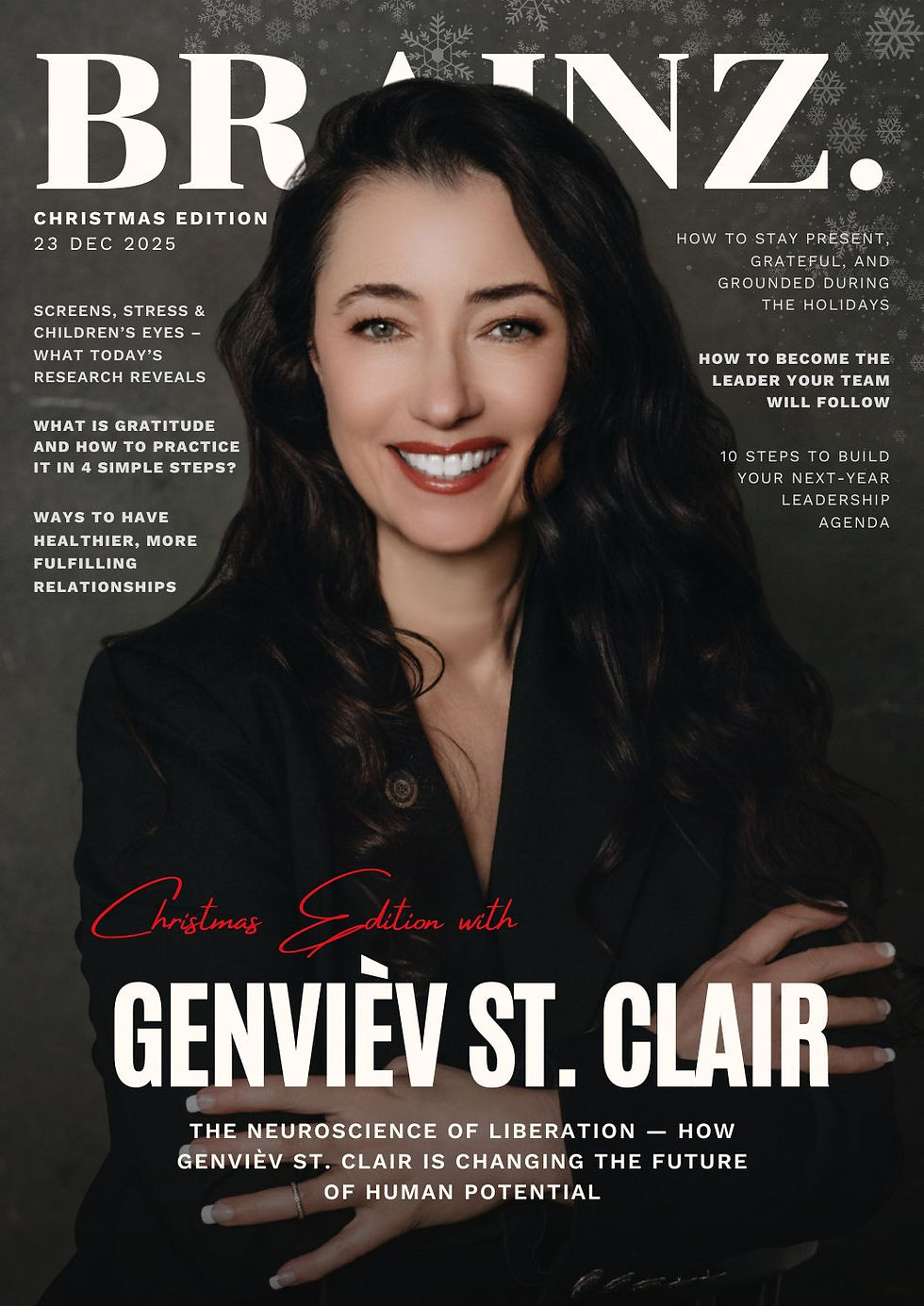A Guide to Anti-Fragile Living and Grow Through What You Go Through
- Brainz Magazine

- Apr 24
- 5 min read
Heidi Albritton is a dynamic Coach & Trainer, with over 20 years of experience in operational excellence and transformative coaching. Notably, she pioneered Mindfulness coaching at a global non-profit, contributing to the creation and facilitation of an organization-wide Mindfulness & Resilience program.

In an era defined by rapid change, rising uncertainty, and global disruption, we’ve all heard the call to become more resilient. But what if resilience isn’t enough? Resilience means bouncing back after hardship or setbacks. It’s admirable, but it still assumes that we’re trying to return to what was. In times of deep transformation, the more powerful question becomes: How can we emerge stronger because of challenge?

This is the heart of the anti-fragile mindset.
The term anti-fragile was coined by Nassim Nicholas Taleb in his seminal book Antifragile: Things That Gain from Disorder. He writes:
“Some things benefit from shocks; they thrive and grow when exposed to volatility, randomness, disorder, and stressors. Anti-fragility is beyond resilience or robustness.”
Think of it this way:
Fragile systems break under pressure.
Resilient systems endure pressure.
Anti-fragile systems actually improve because of it.
Nature is full of anti-fragile design: bones strengthen with impact. Muscles grow through resistance. The immune system learns through exposure. So why not our minds? Why not our leadership?
To cultivate an anti-fragile self or business, we must move beyond endurance and into transformation. This requires more than grit; it requires wisdom and design.
That’s where the value of mindfulness, stoicism, and neuroscience come in, not as buzzwords, but as interlocking tools that help us grow stronger, more adaptable, and more effective in uncertain times.
The anti-fragile mind: A new way to relate to challenge
At its core, being anti-fragile is about how we relate to challenge, not how we avoid it. When disruption hits, anti-fragile individuals don’t just resist, they reflect, reframe, and recalibrate.
This capacity is deeply internal. It starts with how we think, how we perceive stress, and how we build our habits. The good news? All of that is trainable.
Let’s explore how mindfulness and stoicism, two ancient, time-tested disciplines, offer a modern path to becoming anti-fragile, and how neuroscience validates what these traditions have known for centuries.
Mindfulness: Creating space in the storm
Mindfulness is not about escaping discomfort; it’s about turning toward it with awareness and steadiness. This practice strengthens our capacity to be with what is, rather than react impulsively or catastrophize.
When practiced consistently, mindfulness helps cultivate:
Emotional regulation
Focus and attention
Self-awareness under stress
Neuroscience shows that mindfulness physically reshapes the brain. Studies have found that regular mindfulness practice:
Shrinks the amygdala (fear center)
Strengthens the prefrontal cortex (decision-making and regulation)
Enhances connectivity in areas associated with learning and adaptability(Source: Hölzel et al., Psychiatry Research: Neuroimaging, 2011)
In other words, mindfulness doesn’t eliminate stress, it improves your brain’s ability to respond to it constructively.
“Between stimulus and response there is a space. In that space is our power to choose our response. In our response lies our growth and our freedom.”— Viktor E. Frankl
Mindfulness trains us to live in that space. That’s where anti-fragility begins.
Stoicism: Mental armor for uncertain times
While mindfulness helps us observe and stay present, stoicism helps us interpret and act with clarity.
Rooted in ancient Greek and Roman philosophy, stoicism teaches that peace comes not from controlling events, but from mastering how we respond to them. This mindset is critical in a world where so much is outside our control.
“It’s not what happens to you, but how you react to it that matters.”— Epictetus
Modern research supports this. Neuroscience studies show that people with a strong internal locus of control (the belief that we can influence outcomes through our actions) are less reactive to stress and more resilient over time. (Source: Neuropsychologia, 2015)
Stoicism also cultivates values like discipline, perspective, and courage, traits that support clear decision-making in chaos. It encourages us to focus our energy on what we can control: our mindset, our actions, and our integrity.
“You have power over your mind—not outside events. Realize this, and you will find strength.”— Marcus Aurelius
That power is the foundation of anti-fragile thinking.
Neuroscience: Rewiring through challenge
Bringing it all together, neuroscience helps explain why these ancient practices work. Our brains are not fixed, they’re dynamic systems that learn, adapt, and rewire in response to our behavior.
This concept, called neuroplasticity, tells us that each time we choose presence over panic, values over reactivity, or learning over avoidance, we literally strengthen new neural pathways. Over time, those choices become traits.
Stress, when reframed and met with awareness, becomes information. Challenge becomes training. And our brains get stronger.
“The brain is like a muscle. The more you use it, the more it grows.”— Carol Dweck
Anti-fragility in leadership and business
This mindset doesn’t stop at the individual level; it’s also a blueprint for resilient and innovative organizations.
Anti-fragile businesses:
Encourage experimentation and learning from failure
Invest in psychological safety, emotional intelligence, and team adaptability
Prioritize human-centered leadership and mental well-being
Break silos and reward flexible, systems-based thinking
According to a 2020 McKinsey study, companies that invested in adaptability training and emotional well-being saw faster recovery post-crisis and significantly higher engagement.
From fragile to fearless: A call to grow
We’re not here to avoid challenge, we’re here to evolve through it.
To become anti-fragile is to embrace stress as a teacher, not just a test. To stop chasing certainty and instead build the mental, emotional, and neurological agility to meet whatever comes.
By integrating mindfulness, stoicism, and neuroscience, we can develop minds that are calm, focused, and deeply adaptive. And when people lead from that place, so do teams, so do businesses, and so does culture.
“The wind extinguishes a candle, but energizes a fire.”— Nassim Nicholas Taleb
Let’s choose to be the fire.
Heidi Albritton, Mindfulness & High Performance Coach
Heidi Albritton is a dynamic Coach & Trainer, with over 20 years of experience in operational excellence and transformative coaching. Notably, she pioneered Mindfulness coaching at a global non-profit, contributing to the creation and facilitation of an organization-wide Mindfulness & Resilience program. A certified expert in Corporate-based Mindfulness, Advanced Enneagram Dynamics and High Performance Coaching, she's dedicated to helping individuals uncover their potential, manage their emotions, and lead a life of impact. Heidi's personal journey, marked by resilience in the face of Lyme's disease and cancer, fuels her passion for mindfulness and authenticity. Her mantra, "Change your mind, change your life,"










.jpg)